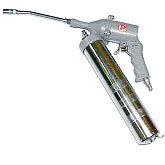Grease gun
This article may need to be rewritten to comply with Wikipedia's quality standards, as per MOS:LAYOUT. (February 2024) |
This article relies largely or entirely on a single source. (February 2024) |

A grease gun is a common workshop and garage tool used for lubrication. The purpose of the grease gun is to apply lubricant through an aperture to a specific point, usually from a grease cartridge to a grease fitting or 'nipple'. The channels behind the grease nipple lead to where the lubrication is needed. The aperture may be of a type that fits closely with a receiving aperture on any number of mechanical devices. The close fitting of the apertures ensures that lubricant is applied only where needed. There are four types of grease gun:
- Hand-powered, where the grease is forced from the aperture by back-pressure built up by hand-cranking the trigger mechanism of the gun, which applies pressure to a spring mechanism behind the lubricant, thus forcing grease through the aperture.
- Hand-powered, where there is no trigger mechanism, and the grease is forced through the aperture by the back-pressure built up by pushing on the butt of the grease gun, which slides a piston through the body of the tool, pumping grease out of the aperture.
- Air-powered (pneumatic), where compressed air is directed to the gun by hoses, the air pressure serving to force the grease through the aperture. Russell Gray, inventor of the air-powered grease gun, founded Graco based on this invention.[citation needed]
- Electric, where an electric motor drives a high-pressure grease pump. These are often battery-powered for portability.
The grease gun is charged or loaded with any of the various types of lubricants, but usually a thicker heavier type of grease is used.
It was a close resemblance to contemporary hand-powered grease guns that gave the nickname to the World War II-era M3 submachine gun.[1]
See also[edit]
References[edit]
- ^ Ingram, Mike (2001). The MP40 Submachine Gun. Zenith Imprint. p. 85. ISBN 0760310149.
